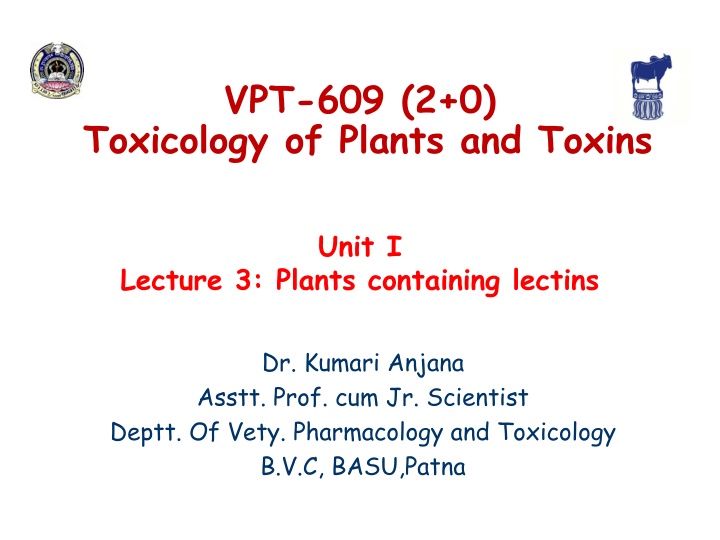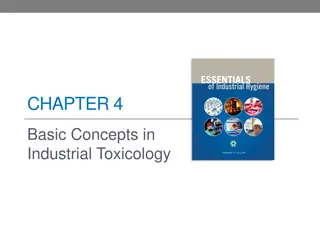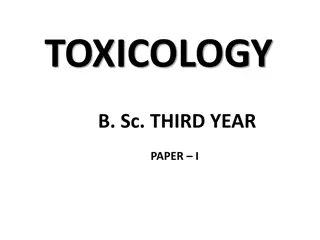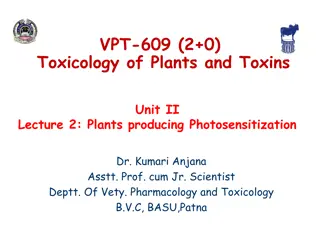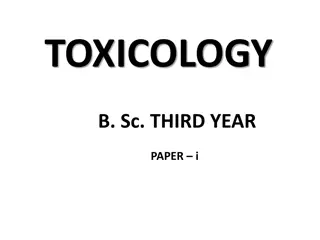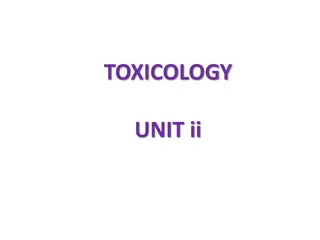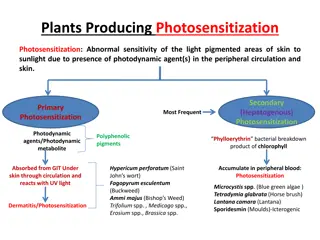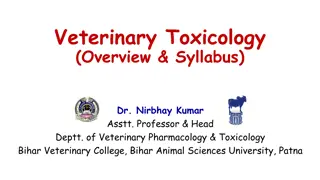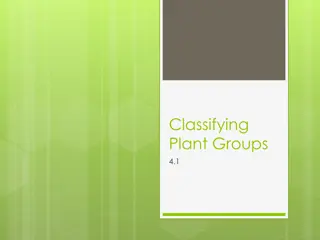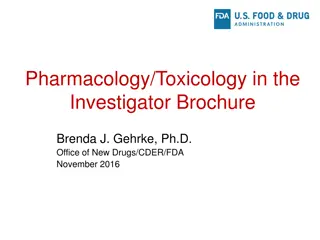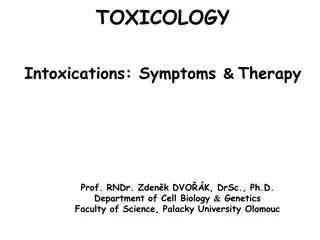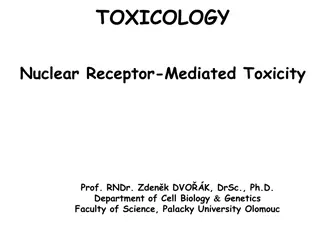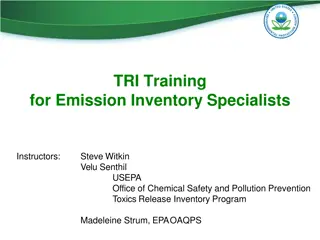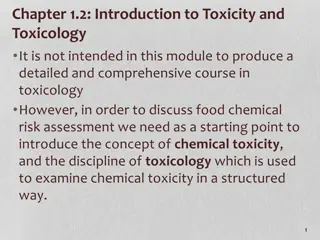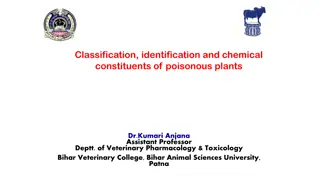Toxicology of Plants: Lectins and Their Toxic Effects
Lectins are carbohydrate-binding proteins found in plants that can survive digestion and cause harmful effects in the digestive system and overall health. Plants like Abrus precatorius contain toxic lectins like abrin that can disrupt protein synthesis and lead to severe toxicity.
Download Presentation

Please find below an Image/Link to download the presentation.
The content on the website is provided AS IS for your information and personal use only. It may not be sold, licensed, or shared on other websites without obtaining consent from the author.If you encounter any issues during the download, it is possible that the publisher has removed the file from their server.
You are allowed to download the files provided on this website for personal or commercial use, subject to the condition that they are used lawfully. All files are the property of their respective owners.
The content on the website is provided AS IS for your information and personal use only. It may not be sold, licensed, or shared on other websites without obtaining consent from the author.
E N D
Presentation Transcript
VPT-609 (2+0) Toxicology of Plants and Toxins Unit I Lecture 3: Plants containing lectins Dr. Kumari Anjana Asstt. Prof. cum Jr. Scientist Deptt. Of Vety. Pharmacology and Toxicology B.V.C, BASU,Patna
Introduction Lectins are carbohydrate binding (glyco) proteins which are ubiquitous in nature. In plants, they are distributed in various families and hence ingested daily in appreciable amounts by both humans and animals. One of the most nutritionally important features of plant lectins is their ability to survive digestion by the gastrointestinal tract of consumers. This allows the lectins to bind to membrane glycosyl groups of the cells lining the digestive tract. As a result of this interaction a series of harmful local and systemic reactions are triggered placing this class of molecules as antinutritive and/or toxic substances.
Locally, they can affect the turnover and loss of gut epithelial cells, damage the luminal membranes of the epithelium, interfere with absorption, stimulate shifts in the bacterial flora and modulate the immune state of the digestive tract. nutrient digestion and Systemically, they can disrupt lipid, carbohydrate and protein metabolism, promote enlargement and/or atrophy of key internal organs and tissues and alter the hormonal and immunological status. At high intakes, lectins can seriously threaten the growth and health of consuming animals.
Abrus precatorius (Sui Poisoning) Other name Rosary pea, Precatory bean, Jequirity bean carb s eye rati The seeds of A.precatorious used as beads in jewellery/ornaments.
Found throughout the tropics. Twining perennial plant with yellow and red flowers and pod like fruits containing oval, shiny red and black seeds. The seeds of A.precatorious used as beads in jewellery/ornaments. It contain a toxalbumin- abrin which is one of the most poisonous phytotoxins (i/v median lethal dose in mice = 0.1 g/kg). Used for malicious killing of animals.
Toxic principle Abrin: Toxic principle of A.precatorious. It is a toxalbumen. It is similar to viper snake venom. Inhibit protein synthesis (cell death). Other active principles are: Abrine (N-methyl tryptophan)- an amino acid, Haemagglutinin, Abralin- a glycoside, Lipolytic enzyme.
The whole seeds when ingested are not toxic (except in poultry). The powder of the seeds is toxic in all species (ruminants, horses and man). Powder of one seed can kill a small child or medium sized dog and 60 G seed powder can kill a horse. Needles/spikes/ nails etc coated with the paste of crushed seeds and inserted into the body cavities or under the skin (sui poisoning) are used for malicious killing of cattle. 2needle stuck into a wooden handle. Blown over the animals. Malicious killing.
Mechanism of toxicity Abrin acts as a proteolytic enzyme and has the highest inhibitory effect on protein synthesis by acting on ribosomes of the cells. It also causes agglutination of RBC (binds to glycoprotein s of the RBC membranes-bridges between the cells). Abrin due to its peculiar binding potential is also selectively transported (suicide transport) by the nerves. Clinical sign: Animals die within 2-4 days after exhibiting salivation, stiffness of joints, ataxia, incoordination, muscular spasms, hyperthermia and convulsions, with extremely painful swelling at the site of implant.
PM lesions: Congestion of visceral organs and petechial haemorrhages throughout the body are seen on PM. Treatment: No specific antidote. Remove the source (from GIT by emesis, gastric lavage, demulcents, saline purgatives etc.) and i/v infusion of fluids and electrolytes.
Ricinus communis (Castor or Arandi) The castor bean is an ornamental plant and is commonly found in jungles and wastelands in tropical areas. It is also cultivated in India for castor oil. All parts of the plant are toxic, but seeds are particularly rich in toxin. Seeds contain 56% oil (castor oil) and 26% proteins. Poisoning results from accidental ingestion or feeding of cake. Susceptible species: All animals are sensitive, But horses are the most susceptible species. Ducks and hens are still more resistant. It is used for malicious killing of animals. In horses ricin may be lethal at a dose as low as 0.007 g/kg, while in others 0.3 g/kg may not be lethal.
Toxic principles The pomace or castor cake (residue left after oil extraction of the seeds) contains the phytotoxin ricins: ricin I and ricin II (lectins absorbed from GIT). Ricin II is more toxin than ricin I. Ricin (toxalbumins) consists of two peptide chains chain A and Chain B joined by sulphide bonds. The castor seeds also contain several; other toxic and non toxic proteins and alkaloids, some of which have not been clearly defined. Castor beans contain: a toxic alkaloid ricinine, an irritant and purgative ricinoleic acid, a powerful haemaglutinin RCA (Ricinus communis agglutinin).
Poisoning by ingestion of the castor bean is due to ricin, not RCA, because RCA does not penetrate intestinal wall and does not affect red blood cells unless given intravenously. If RCA is injected into blood, it will cause the RBCs to agglutinate and burst by haemolysis. Ricin toxin : It is plant proteins, is one of the most powerful phytotoxins . 1 mg of pure toxin can be isolated from 1gm of seeds. It is heat labile and destroyed by heating. Aging also reduces toxicity of phytotoxins. Ricin resembles bacterial exotoxins, animals can be hyperimmunized to it. Heat (about 56 C) destroys the toxic fraction (toxophore) and leaves an immunizing fraction (haptophore). Boiling of the meal or whole seeds makes them nontoxic. Immunity can be developed in cattle and calves by feeding increasing amounts of castor beans.
Mechanism of toxicity Exact mechanism of toxic action of ricin is not known. But ricin appears to induces hydrolytic fragmentation or ribosomes and their inactivation and thus inhibits protein synthesis. Chain A of ricin inactivates the 60S ribosomal subunit of cells and blocks protein synthesis and is endocytosed into the cell cytosol after chainB binds to a terminal galactose residue on the cell membrane. Ricin also damages: GI mucosa - impairs digestion and absorption of nutrients. Hepatocytes - liver damage, hepatitis. Renal tubules - nephrosis.
Clinical signs A characteristic latent period (2-3 days) between ingestion of castor beans or cake and the onset of clinical signs. The general signs : nausea, vomiting, signs of abdominal pain (grinding of teeth, humping of back) and gradually development of diarrhoea. It is followed by sever gastroenteritis, bloody diarrhoea, dehydration and icterus in fatal cases. Horses main clinical signs are dullness, incoordination, profuse sweating, muscular spasms and tumultuous heart (beating with such force shaking the entire body), watery diarrhoea and abdominal cramps. All animals show profuse watery diarrhoea, icterus, colic, oliguria, prostration, convulsions and death. Animals may develop immunity by injection of the toxin in gradual increasing doses.
Treatment Cattle become immune by feeding the increasing amounts of the bean. The solutions of the toxin become nontoxic, but retain immunogenic properties by heating (coagulation). Treatment consists of giving anti- recin serum (from previously hyper immunized animal). Removal of the poison (gastric lavage and saline purgatives). Fluid and electrolyte therapy, saline diuretics and urinary alkalizers.
